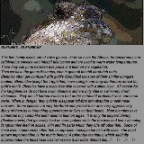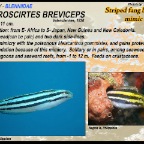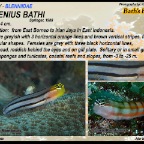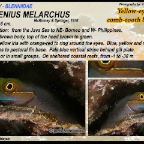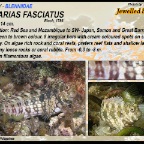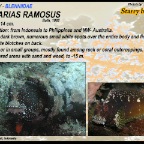Blennies - Blenniidae
BLENNIES - BLENNIIDAE
This fish family exists out of a few genera. First we have the Alticus, Entomacrodus and Istiblennius species who inhabit tidal zones and are used to warm water temperatures. There they can jump between tide pools and feed on the vegetation. Then we have the genus Ecsenius, who in general inhabit coral-rich reefs. Blennies often get confused with Gobi's (Gobiidae) because of their similar elongate bodies. Blenniidae (exept the tripplefins) have a single and long continuous dorsal fin. Gobi's don’t! Blennies have a scale-less skin covered with a slime layer. All except for the fangblennies do not have swim bladders and are only able to swim very short distances. They are all bottom dwellers that prefer to inhabit protected rock- and coral reefs. When they are in danger they quickly disappear tail-first into abandon or self-made burrows. Some species are very territorial and protect their area very aggressively. Many of them have branching appendages or Cirri on their heads. Most blennies have numerous tiny comb-like teeth used to feed on algae. It is only the leopard blenny (Exalias brevis) that generally feed on coral polyps while the tire-less and fast swimming fangblennies feed on scales, skin and fin parts which they bite off other fish. Some of them even impersonate other fish to approach unsuspected fish with ease. The most known impersonation is the mimic blenny (Aspidontus taeniatus) which skillfully impersonates the bluestreak cleaner wrasse (Labroides dimidiatus). Members of the genus Meiacanthus have venom glands associated with their teeth. They are avoided by predators because of this defensive adaption and can swim in open water without any danger to feed on planktonic worms and crustaceans. When not feeding, fangblennies rest in worm holes with only their heads exposed. Blennies lay their eggs in small cracks, underneath stones or empty shells which will be guarded by the male or both of them. The larvae stage is very short.
Length: 53 cm.Distribution: Red Sea, E- Africa, S- Japan, Line Is, Fr. Polynesia, New Caledonia, Austr.The longest blenny of the family, resembles an eel. Dark-brown to black bands with light-blue margins. Dorsal fin starts on the head and goes down to the tail-tip. Light-blue lining on the head. Lives solitary in sand or mud bottoms close to reefs, from -2 to -20 m. During the day mostly in burrow with the head exposed. Length: 7,5 cm.Distribution: From N- Indonesia and Philippines to Palau, Solomon Is and Fiji.Head with fine white to yellow spots. Body has a yellowish undercolour with 13-14 reddish vertical bars. Lives solitary on coral outcrops from sheltered reefs downto -8 m. Length: 5 cm.Distribution: From Indonesia to Philippines and NW- Australia.Light to dark brown, numerous small white spots over the entire body.Solitary, mostly found on rock or coral outcroppings. In sheltered areas with sand and weed, to -5 m. Length: 14 cm.Distribution: Red Sea and Mozambique to SW- Japan, Samoa and Great Barrier Reef.Olive green to brown colour. 8 irregular bars with cream coloured spots on sidesand belly. On algae rich rock and coral reefs, prefers reef flats and shallow lagoons with many loose rocks or coral rubble. From -0,3 to -8 m.Feeds on filamentous algae. Length: 7 cm.Distribution: From Sri Lanka to, S- Japan, Samoa and Great Barrier reef.Grayish with small white spots on the head and dashed lines on the body. Two unbranched tentacles above the eyes. Solitary, in lagoons and on sheltered coastal reefs down to -8 m. Length: 12 cm.Distribution:Red Sea & S- Africa, S- Japan, Line Is, Marquesas Is, Lord Howe Is, G.B.R.From almost black-orange to dark yellow, two blue stripes from snout to tail.Juveniles mimic the cleaner wrasse Labroides dimidiatus. They feed on skin, mucusand fish scales. Hides in small holes like deserted tubeworms. Solitary, coral-rich lagoons and seaward reefs, from -1 to -40 m. Length: 34 cm.Distribution: Philippines and E- Borneo to S- Flores,Papua New Guinea, Solomon Is.Juveniles resemble the catfish Plotosus lineatus, but doesn’t have the venomousspines and barbels. Adults pale yellow with dark brown to black saddles and patches.Juveniles in schools near the bottom, often resting under ledges or under coral heads. Adults in holes near coral heads, wrecks or under ledges. In shallow lagoons and coastal reefs, from -3 to -30 m. Length: 11 cm.Distribution: From E- Africa to New Guinea, S- jpan and New Caledonia.Yellow head(can be pale) and two dark side-lines. Shows mimicry with the poisones Meiacanthus grammistes, and gaines protectionfrom predation because of this.Lives on seaweeds in sandy lagoons and seaward reefs, from -1 to 12 m. Length: 11 cm.Distribution: Philippines, Bali to Micronesia, Samoa, SW- Japan, G.B.R & N. Caledonia. Many variants, depending the aria. Bluish head, blue-greyish body with yellow stripe on back. Pale blue margined black diogonal line above eyes. Adults with filamented tail fin. Below the surge zone, in lagoons and on seaward reefs, from -1 to -30 m. Length: 14,5 cm.Distribution: R. Sea & S- Africa to S.W- Japan, Hawaii, Fr. Polynesia and N. Caledonia.White to pale red body with numerous brown to red spots, which have a darker dot in it’s interior. Cirri above the eyes and on the neck, numerous papillae on upper lip. Solitary, on or between Pocillopora, Seriatopora, Porites and Millepora corals.Coral-rich coastal reefs, from -3 to -20 m. Length: 5 cm.Distribution: At the moment only known from the Philippines. Thick horizontal orange lines which are intersected by vertical orange to brown lines. This forms white rectangular shapes. Two white lines in the eye’s.On coral reefs, down to 34 m. Usually below -10 m. Length: 6 cm.Distribution: From the Philippines to Molucca- and Raja Ampat Is. Indonesia.Bottem part of the head is paler than the top part, blue, white and pale orange horizontal lining at the middle of the head. Dark orange to brown body, black spot with white edge on tailbase. Yellow iris and orange circle around the eyes. Mostly solitary on coastal reefs and lagoons, from -2 to -30 m. Length: 5 cm.Distribution: Philippines, Molucca Is. and Solomon Is.Bottempart of the head is pale pink while the top part is yellowish-brown. Dark body with white horizontal lines and white dots on upper and mid-lateral line.Dark red and yellow vertical lines on tail base. Yellow to white lines in the eye’s. On seaward reefs, from -10 to -40 m. Length: 10 cm.Distribution: From the Philippines to SW- Japan, Moluccas and Solomon Is.Colour variable, from blue to different tones of brown. Yellow or greyish tail fin.The larger specimen have irregular lines next to the eyes and on cheeck.Lives on coral and sponges. Common, lagoons and seaward reefs down to -30 m.Length: 6 cm.Distribution: From the Java Sea to NE- Borneo and W- Philippines.Grey to brown body, top of the head brown to green. Bright yellow iris with orange-red to ring around the eyes. Blue, yellow and red stripe from eyes to pectoral fin base. Pale blue vertical stripe behind gill plate.Solitary or in small groups. On sheltered coastal reefs, from -1 to -30 m. Length: 4,5 cm.Distribution: from NE- Borneo to the Philippines.Different shades of brown, lower head and belly white-pinkish.Two black spots on the sides, black and white line behind and beween the eyes.Lower part of the eye white, pale line above the iris. Solitary or in small groups, on coastal and outer reefs, from -1 to -15 m. Length: 11 cm.Distribution: from Maldives to SW- Japan, Micronesia, Phoenix Is. & Fiji, South G.B.R.Can be found in two colour phases, head and front part of the body dark greyish, with yellow-orange tail- base and fin. Other var. broad white lateral band, brown to black back and with or without yellow-orange tail fin. Long strait cirri (antenna), and arched line under the eyes. Solitary, lagoons, outer- and seaward reefs, from -1 to -25 m. Length: 5 cm.Distribution: From Sulawesi & Irian Jaya to Papua New Guinea and Solomon Is.There are two colour variations: white body with broad orange horizontal lines andfive black vertical lines on rear body. The other is grey-ish with three black horizontallines and a pink-yellow head. Both have a ocellated spot above the pectoral fin base, a very short but thick orange line on pectoral fin base and two fine lines in the eye. Solitary or in small groups on hard corals, on outer reef slopes from -8 to -30 m. Length: 10 cm.Distribution: From the South China Sea to Tonga, Ryukyus and Great Barrier Reef.Easy to recognise by the dark spot in the neck. On seaward reefs, from -1 to -25 m. Usually not deeper than 10 m.Feeds on algae. Length: 13 cm.Distribution: Red Sea to Marquesas- & Tuam Is, S- Japan and New South Wales.A mimic of the cleaner wrasse Lambroides dimidiatus, this gives them the chanse to approach other fish and nibble of their fins, skin and scales. Because of their mimic, they gain protection from predation. Also feeds on tubeworms and fish eggs.Lives in empty worm tubes, in lagoons and on seaward reefs from -1 to -20 m.


